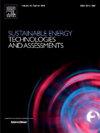Integrated resource strategic planning considering inter-regional flexibility supply–demand balance: A case study for the Northwest and Central Grid in China
IF 7.1
2区 工程技术
Q1 ENERGY & FUELS
Sustainable Energy Technologies and Assessments
Pub Date : 2024-10-05
DOI:10.1016/j.seta.2024.104019
引用次数: 0
Abstract
China’s rapid advancement in renewable energy and regional power grid interconnection has highlighted the need for enhanced system flexibility to ensure the security and stability of regional power systems. To address this issue, this study presents a new framework for integrated resource strategic planning for inter-regional flexibility (IRSP-IF). This framework evaluates inter-regional flexibility demand and optimizes power resource allocation across regions. The northwest and central grids in China are used as case studies to evaluate inter-regional power resource allocation from 2022 to 2035. This analysis considers key factors including flexibility supply–demand balance constraints, regional power grid interconnections, and time scales for assessing flexibility demand. The results show that incorporating these constraints and interconnections into the strategic power plan enables greater integration of renewable energy while reducing both installed capacity and the overall cost of regional power resources. In the S3 scenario, which includes inter-regional flexibility supply–demand balance, the total integration of wind and solar power increases by 1.54%. Additionally, the combined average annual fixed and operating costs decrease by 1.44 billion yuan compared to the S2 scenario, which only considers single-region flexibility supply–demand balance. Furthermore, evaluating flexibility demand at a shorter time scale results in a higher proportion of flexible resources, with an average annual growth of 24.43%.
考虑区域间灵活性供需平衡的综合资源战略规划:中国西北和华中电网案例研究
中国在可再生能源和区域电网互联方面的快速发展凸显了增强系统灵活性以确保区域电力系统安全性和稳定性的必要性。为解决这一问题,本研究提出了一个新的区域间灵活性综合资源战略规划框架(IRSP-IF)。该框架可评估跨区灵活性需求,优化跨区电力资源配置。研究以中国西北电网和华中电网为例,评估了 2022 年至 2035 年的跨区电力资源配置情况。该分析考虑了包括灵活性供需平衡约束、区域电网互联和灵活性需求评估时间尺度在内的关键因素。结果表明,将这些限制和互联纳入战略电力计划,可在降低装机容量和地区电力资源总体成本的同时,实现更大程度的可再生能源整合。在包含区域间灵活性供需平衡的 S3 情景中,风能和太阳能发电的总集成量增加了 1.54%。此外,与只考虑单区域灵活性供需平衡的 S2 情景相比,年平均固定成本和运营成本合计减少了 14.4 亿元。此外,在更短的时间尺度上评估灵活性需求可提高灵活性资源的比例,年均增长率为 24.43%。
本文章由计算机程序翻译,如有差异,请以英文原文为准。
求助全文
约1分钟内获得全文
求助全文
来源期刊

Sustainable Energy Technologies and Assessments
Energy-Renewable Energy, Sustainability and the Environment
CiteScore
12.70
自引率
12.50%
发文量
1091
期刊介绍:
Encouraging a transition to a sustainable energy future is imperative for our world. Technologies that enable this shift in various sectors like transportation, heating, and power systems are of utmost importance. Sustainable Energy Technologies and Assessments welcomes papers focusing on a range of aspects and levels of technological advancements in energy generation and utilization. The aim is to reduce the negative environmental impact associated with energy production and consumption, spanning from laboratory experiments to real-world applications in the commercial sector.
 求助内容:
求助内容: 应助结果提醒方式:
应助结果提醒方式:


